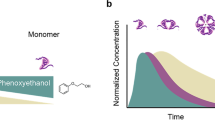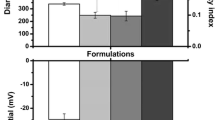Abstract
A chemically modified, amorphous β-cyclodextrin, namely, 2-hydroxypropyl-β-cyclodextrin (HPCD), was examined as a solubilizing and stabilizing agent for protein drugs. The aqueous solubility of ovine growth hormone at pH 7.4 was increased through the use of HPCD. This effect was manifested by higher UV transparency at 600 nm. Interleukin-2 (IL-2) is rendered insoluble upon lyophilization in the absence of stabilizers. Use of aqueous HPCD provides a clear solution, as indicated by fluorometric light scattering, and inhibits aggregate formation, as shown by ultracentrifugation and Western blot analyses. In addition, there were no major conformational changes of IL-2 in HPCD formulation as indicated by fourth-derivative ultraviolet spectroscopy. Finally, IL-2 retained 100% of its biopotency when prepared in HPCD solutions. Aggregation of insulin was also suppressed by HPCD. These data, as well as the i.v. safety of HPCD and its well-characterized chemical composition, suggest that this starch derivative may be a potentially useful excipient for protein drugs intended for parenteral use.
Similar content being viewed by others
REFERENCES
J. Wang and M. Hanson. Parenteral formulation of proteins and peptides: Stability and stabilizers. J. Parenteral Sci. Technol. 42(Suppl):S2–S26 (1988).
M. Manning, K. Patel, and R. Borchardt. Stability of protein pharmaceuticals. Pharm. Res. 6:1903–1918 (1989).
K. Uekama and M. Otagiri. Cyclodextrins in drug carrier systems. CRC Crit. Rev. Ther. Drug Carrier Syst. 3:1–20 (1987).
D. Frank, J. Gray, and R. Weaver. Cyclodextrin nephrosis in the rat. Am. J. Pathol. 83:367–382 (1976).
Y. Hiasa, M. Ohshima, Y. Kitahori, T. Yuasa, T. Fujita, C. Iwata, A. Miyashiro, and N. Konishi. Histochemical studies of β-cyclodextrin nephrosis in rats. J. Nara. Med. Assoc. 32:316–326 (1981).
J. Perrin, P. Field, D. Hansen, R. Mufson, and G. Torosian. β-Cyclodextrin as an aid to peritoneal dialysis. Renal toxicity of β-cyclodextrin in the rat. Res. Commun. Chem. Path. Pharm. 19:373–376 (1978).
A. Yoshida, H. Arima, K. Uekama, and J. Pitha. Pharmaceutical evaluation of hydroxyalkyl ethers of β-cyclodextrins. Int. J. Pharm. 461:217–222 (1988).
M. Brewster, K. Estes, and N. Bodor. An intravenous toxicity study of 2-hydroxypropyl-β-cyclodextrin. Int. J. Pharm. 59:231–243 (1990).
J. Pitha, T. Irie, P. Sklar, and J. Nye. Drug solubilizers to aid pharmacologists: Amorphous cyclodextrin derivatives. Life Sci. 43:394–502 (1988).
J. Pitha, J. Milecki, H. Fales, L. Pannell, and K. Uekama. Hydroxypropyl-β-cyclodextrin: Preparation and characterization; Effects of solubility of drugs. Int. J. Pharm. 29:73–82 (1986).
J. Pitha. U.S. Patent 4,727,064 (1988).
T. Irie, K. Fukanaga, A. Yoshida, K. Uekama, H. Fales, and J. Pitha. Amorphous water-soluble cyclodextrin derivatives. Pharm. Res. 5:713–717 (1988).
J. Pitha and J. Pitha. Amorphous water-soluble derivatives of cyclodextrins: Nontoxic dissolution enhancing excipients. J. Pharm. Sci. 74:987–990 (1985).
M. Brewster, J. Simpkins, M. Hora, W. Stern, and N. Bodor. Potential use of cyclodextrins in parenteral formulations. J. Parent. Sci. Technol. 43:231–240 (1989).
S. Gillis, M. Ferm, W. Ou, and K. Smith. T cell growth factor: Parameters of production and a microassay for activity. J. Immunol. 120:2027–2033 (1978).
T. Landefeld and J. Suttie. Changes in messenger ribonucleic acid concentration and plasma levels of growth hormone during ovine estrous cycle and in response to endogenous estradiol. Endocrinology 125:1474–1478 (1987).
M. Fletcher and A. Goldstein. Recent advances in the understanding of the biochemistry and clinical pharmacology of interleukin-2. Lymphokine Res. 6:45–57 (1987).
K. Smith. Interleukin-2: Inception, impact and implications. Science 240:1169–1176 (1988).
R. Mertelsmann and K. Welte. Human interleukin-2: Molecular biology, physiology and clinical possibilities. Immunobiology 172:400–419 (1986).
S. Rosenberg, M. Lotze, and J. Mule. New approaches to the immunotherapy of cancer using interleukin-2. Ann. Intern. Med. 108:853–864 (1988).
W. Butler. Fourth derivative spectra. Methods Enzymol. 56:501–515 (1979).
E. Padros, A. Morros, J. Manosa, and M. Dunach. The state of tyrosine and phenylalanine residues in proteins analyzed by fourth derivative spectrophotometry. Eur. J. Biochem. 127:117–122 (1982).
J. Brandts and L. Kaplan. Derivative spectroscopy applied to tyrosyl chromophores. Biochemistry 12:2011–2024 (1973).
M. Durach, M. Sabes, and E. Padros. Fourth derivative spectroscopy analysis of tryptophan environment in protein. Eur. J. Biochem. 134:123–128 (1983).
C. Peterson and M. Blackburn. Antithrombin conformation and the catalytic role of heparin. J. Biol. Chem. 262:7559–7566 (1987).
M. Hagenlocher and R. Pearlman. Use of a substituted cyclodextrin for stabilizing of solutions of recombinant human growth hormone. Pharm. Res. 6:S30 (1989).
Author information
Authors and Affiliations
Rights and permissions
About this article
Cite this article
Brewster, M.E., Hora, M.S., Simpkins, J.W. et al. Use of 2-Hydroxypropyl-β-cyclodextrin as a Solubilizing and Stabilizing Excipient for Protein Drugs. Pharm Res 8, 792–795 (1991). https://doi.org/10.1023/A:1015870521744
Issue Date:
DOI: https://doi.org/10.1023/A:1015870521744




